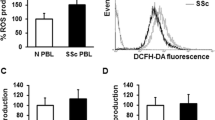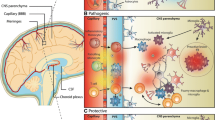Abstract
Lipid-laden macrophages, which are predominantly derived from blood monocytes, are present at sites of active multiple sclerosis demyelination and are assumed to be involved in the demyelinating process. These inflammatory cells produce a variety of toxic oxygen metabolites which can mediate host tissue destruction. We measured production of two oxygen metabolites by monocytes and polymorphonuclear leukocytes in MS patients and controls. Stimulated monocytes produced significantly more hydrogen peroxide, superoxide, and chemiluminescence in the MS group than controls. The polymorphonuclear leukocyte, an inflammatory cell that appears to contribute little to MS demyelination, did not demonstrate increased production of toxic oxygen metabolites in the MS patients as compared to controls. These results suggest that blood monocytes in MS patients are primed to produce increased amounts of cytotoxic oxygen metabolities when exposed to inflammatory stimuli.
Similar content being viewed by others
References
Weiner, H. L., andD. A. Haffler. 1986. Multiple sclerosis, Chap. 6.In Current Neurology. S. H. Appel, editor. Yearbook Medical Publishers Chicago, p. 123–151.
Ellison, G. W., B. R. Wissocher, M. C. Graves, andJ. L. Fahey. 1984. Multiple sclerosis.Ann. Intern. Med. 101:514–526.
Prineas, J. W., andR. G. Wright. 1978. Macrophages, lymphocytes and plasma cells in the perivascular compartment in chronic multiple sclerosis.Lab Invest. 38:409–421.
Matthews, W. B., E. D. Acheson, J. R. Batchelor, andR. O. Weller. 1985. McAlpine's Multiple Sclerosis. Churchill Livingstone, Edinburgh. 302–307.
Traugott, U., E. L. Reinherz, andC. S. Raine. 1983. Multiple sclerosis. Distribution of T cell subsets and ia-positive macrophages in lesions of different ages.J. Neuroimmunol. 4:201–221.
Hauser, S. L., A. K. Bhan, F. Gilles, M. Kemp, C. Kerr, andH. L. Weiner. 1986. Immunohistochemical analysis of the cellular infiltrate in multiple sclerosis lesions.Ann. Neurol. 19:578–587.
Klebanoff, S. J. 1980. Oxygen metabolism and the toxic properties of phagocytes.Ann. Intern. Med. 93:480–489.
Fantone, J. C. andP. A. Ward. 1982. Role of oxygen-derived free radicals and metabolites in leukocyte-dependent inflammatory reactions.Am. J. Pathol. 107:397–418.
Cassanova, M. F., J. C. Troncoso, D. L. Price. 1986. Hematogenous origin of brain macrophages: a case report.Neurology 36:844–847.
Poser, C. M., D. W. Paty, L. C. Scheinberg, W. I. McDonald, F. A. Davis, G. C. Ebers, K. P. Johnson, W. A. Sibley, D. H. Silverberg, andW. W. Tourtellotte. 1983. New diagnostic criteria for multiple sclerosis: Guidelines for research protocols.Ann. Neurol. 13:227–231.
Stock, J. L., andJ. A. Coderre. 1982. Calcitonin and parathyroid hormone inhibit accumulation of cycle AMP in stimulated human mononuclear cells.Biochem. Biophys. Res. Commun. 109:935–942.
Levine, P. H., J. C. Hardin, K. L. Scoon.andN. I. Krinsky. 1981. Effect of corticosteroids in production of superoxide and hydrogen peroxide and the appearance of chemiluminescence by phagocytosing polymorphonuclear leukocytes.Inflammation 5:19–27.
Krinsky, N. I., K. L. Scoon, J. C. Hardin, andP. H. Levine. 1977. Source of hydrogen peroxide and chemiluminescence observed in activated human platelets.Blood 50:597–602.
Andreae, W. A. 1955. A sensitive method for the estimation of hydrogen peroxide in biological metals.Nature 14:859–861.
Curnutte, J. T., andB. M. Babior. 1974. Biological defense mechanisms. The effects of bacteria and serum on superoxide production of granulocytes.J. Clin. Invest. 53:1662–1674.
VanGelder, B. F., andE. C. H. Slater. 1962. The extinction coefficient of cytochromec.Biochem. Biophys. Acta 58:593.
Nathan, C. F., L. Pruckner, S. C. Silverstein, andZ. A. Cohn. 1979. Extracellular cytolysis by activated macrophages and granulocytes.J. Exp. Med. 149:84–99, 100–113.
Simon, R. H., C. H. Scroggin, andD. Patterson. 1981. Hydrogen peroxide causes the fatal injury to human fibroblasts exposed to oxygen radicals.J. Biol. Chem. 256:7181–7186.
Kurosaka, M., andM. Ziff. 1983. Immunoelectron microscopic study of the distribution of T cell subsets in rheumatoid synovium.J. Exp. Med. 158:1191–1210.
Pineas, J. W. 1981. Pathology of the Guillain-Barre syndrome.Ann. Neurol. 9(suppl):6–19.
Werns, S. W., M. J. Shea, andB. R. Luccehesi. 1986. Free radicals and myocardial injury: Pharmacologic implications.Circulation 74:1–5.
McCord, J. 1985. Oxygen-derived free radicals in postischemic tissue injury.N. Engl. J. Med. 321:159–163.
Wolinksy, J. S., B. Jubelt, S. Burke, andD. Narayan. 1982. Hematogenous origin of the inflammatory response in acute poliomyelitis.Ann. Neurol. 11:59–68.
Cameron, D. J., andW. H. Churchill. 1979. Cytotoxicity of human macrophages for tumor cells. Enhancement by human lymphocyte mediators.J. Clin. Invest. 64:977–984.
Nakagawara, A., N. M. Desantis, N. Nogueira, andC. F. Nathan. 1982. Lympohkines enhance the capacity of human monocytes to secrete reactive oxygen intermediates.J. Clin. Invest. 70:1042–1048.
Nathan, C. F., T. J. Prendergast, M. E. Wiebe, E. R. Stanley, E. Platzer, H. G. Remold, K. Welte, B. Y. Rubin, andH. W. Murray. 1984. Activation of human macrophages. Comparison of other cytokines with interferon-gamma.J. Exp. Med. 160:600–605.
Hamman, K. P., andH. C. Hopf. 1986. Determinations of interferon gamma in the peripheral blood of multiple sclerosis patients in remission, using a chemiluminescence technique.J. Neuroimmunol. 13:9–18.
Hammann, K. P., W. Nix, M. P. Dierich, andH. C. Hopf. 1983. Multiple sclerosis patients show an increased spontaneous activity of their peripheral blood monocytes as measured by chemiluminescence.Acta. Neurol. Scand. 68:151–156.
Dore-Duffy, P., andR. B. Zurier. 1981. Lymphocyte adherence in multiple sclerosis. Role of monocytes and increased sensitivity of MS lymphocytes to prostaglandin E.Clin. Immunol. Immunopathol. 19:303–313.
Kuehl, F. A., J. L. Humes, R. W. Egan, E. A. Ham, G. C. Beveridge, andC. G. Van Arman. 1977. Role of prostaglandin endoperoxide PGG2 in inflammatory processes.Nature 265:170–173.
Author information
Authors and Affiliations
Rights and permissions
About this article
Cite this article
Fisher, M., Levine, P.H., Weiner, B.H. et al. Monocyte and polymorphonuclear leukocyte toxic oxygen metabolite production in multiple sclerosis. Inflammation 12, 123–131 (1988). https://doi.org/10.1007/BF00916395
Issue Date:
DOI: https://doi.org/10.1007/BF00916395




